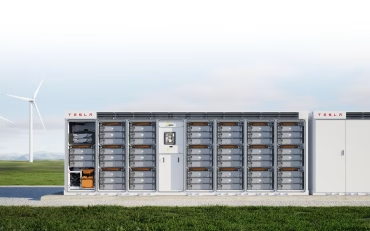
Tesla Energy Storage Revenue Surges Past $10 Billion in 2024
6 minute read

Energy Storage Division Hits Record Revenue as Tesla’s Global Battery Installations Double in Scale
Three Key Facts
- Tesla’s energy storage revenue exceeded $10 billion in 2024, representing a 67% year-over-year increase, with Q4 2024 alone showing a 113% surge over the previous year
- The company deployed 31.4 GWh of storage capacity in 2024, more than doubling its 2023 output with a 114% increase, while both Powerwall and Megapack products remain supply constrained
- Tesla’s latest installations, including the Collie battery in Western Australia at 560 MW/2,240 MWh capacity, are nearly 20 times larger than the company’s earlier projects
Introduction
Tesla has transformed from an electric vehicle manufacturer into a dominant force reshaping the global energy landscape. The company’s energy storage division recently achieved remarkable financial milestones, with revenue surpassing $10 billion in 2024 and deployment capacity more than doubling from the previous year.
Tesla Energy APAC leader Josef Tadich recently highlighted the company’s progress since installing its first large battery at Hornsdale in 2017. The technology has advanced to the point where Australia can realistically pursue 100 percent renewable energy, marking a significant shift in how nations approach their energy infrastructure.
Key Developments
Tesla’s expansion strategy centers on vertical integration and manufacturing scale. The company controls the entire battery value chain, from material recycling to deploying large-scale systems like the Megapack. This comprehensive approach allows Tesla to maintain quality standards while reducing costs across all production stages.
The new Shanghai Megapack factory represents a crucial component of Tesla’s global expansion. Currently operating at 20 GWh capacity with plans to reach 40 GWh annually, this facility complements Tesla’s California operations. Together, these manufacturing centers position the company to meet surging worldwide demand for energy storage solutions.
Recent installations demonstrate the scale of Tesla’s technological advancement. Projects like the Collie battery system showcase capacity increases that were unimaginable just a few years ago, with current systems dwarfing earlier installations by factors of twenty or more.
Market Impact
The financial performance of Tesla’s energy division reflects broader market trends toward renewable energy adoption. Q4 2024 results showed particularly strong momentum, with storage deployment figures indicating sustained demand across multiple market segments. Both residential Powerwall units and commercial Megapack systems face supply constraints as production struggles to keep pace with orders.
Tesla’s stock performance illustrates investor uncertainty about the company’s evolving business model. While energy storage results exceeded expectations, weaker automotive sector performance created volatility. This dynamic highlights how investors view Tesla’s transformation from a car company into a diversified energy technology provider.
Industry analysts note that falling battery costs enhance Tesla’s competitive position. The company’s software capabilities and integrated manufacturing approach provide advantages that competitors find difficult to replicate, particularly as market demand accelerates.
Strategic Insights
Tesla’s software development distinguishes its energy storage offerings from traditional battery manufacturers. Advanced grid management capabilities allow Tesla systems to provide multiple revenue streams for operators while helping stabilize renewable energy integration. These software features smooth intermittency issues that have historically challenged renewable energy adoption.
The company’s vertical integration strategy extends beyond manufacturing into deployment and ongoing system management. This comprehensive approach creates customer relationships that extend well beyond initial equipment sales, establishing recurring revenue opportunities through software updates and grid services.
Geographic expansion patterns reveal Tesla’s strategic priorities. The Australian market serves as a testing ground for technologies and approaches that the company later applies in other regions, making early adoption experiences particularly valuable for global expansion planning.
Expert Opinions and Data
Industry experts emphasize Tesla’s unique market position. CEO Elon Musk recently predicted that annual shipments could reach 100 GWh, describing the energy storage business as “growing like wildfire.” This projection reflects confidence in both manufacturing capabilities and market demand sustainability.
Tadich’s recent discussion with energy analysts Giles Parkinson and David Leitch covered innovations spanning inverter technology, cell pricing developments, battery design improvements, and vehicle-to-grid integration possibilities. The Energy Insiders Podcast explored these technological advances and their implications for grid transformation.
Australian energy experts view Tesla’s success as indicative of broader market trends. The maturity of current battery technology makes the transition to fully renewable energy systems increasingly feasible, with Tesla’s installations providing proof of concept for larger-scale implementations.
Market analysis suggests Tesla’s integrated approach creates competitive advantages that extend beyond pure hardware performance. The combination of manufacturing efficiency, software capabilities, and service integration creates barriers for competitors while enhancing customer value propositions.
Conclusion
Tesla’s energy storage division has established itself as a major force in the global transition toward renewable energy infrastructure. The company’s comprehensive approach, spanning manufacturing, software development, and system integration, has created a sustainable competitive advantage in a rapidly expanding market.
Financial performance metrics demonstrate both the scale of current operations and the potential for continued growth. With supply constraints indicating strong demand across product lines, Tesla’s energy division appears positioned to maintain its leadership role as markets worldwide accelerate renewable energy adoption.





